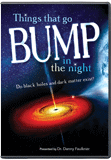
Building Blocks In Space Rocks—The Wellspring of Life?
News Source
The verdict is in: the “building blocks of life” are found in meteorites. About five percent of meteorites harbor organic (carbon-containing) compounds. Whenever organic molecules are found in these rocks, investigators must consider whether the material really came from space or hopped aboard after arrival on earth. Goddard Space Flight Center’s new study provides good evidence that molecules like DNA’s components are genuine meteorite baggage.
DNA and RNA, which contain chains of nucleobases, are the large molecules in which blueprints for living things are encoded. “People have been discovering components of DNA in meteorites since the 1960’s, but researchers were unsure whether they were really created in space or if instead they came from contamination by terrestrial life,” said Dr. Michael Callahan. “For the first time, we have three lines of evidence that together give us confidence these DNA building blocks actually were created in space.”
Callahan’s team analyzed a dozen carbon-containing meteorites, most from Antarctica and Australia. They found four kinds of nucleobases. Two of the nucleobases, adenine and guanine, are found in DNA. Two others, hypoxanthine and xanthine, are biologically significant.
The presence of similar compounds without a significant role in terrestrial biochemistry, however, bolstered belief that the nucleobases were not contaminants.
The presence of similar compounds without a significant role in terrestrial biochemistry, however, bolstered belief that the nucleobases were not contaminants. The team found three kinds of nucleobase analogs—molecules with structures resembling nucleobases.
“You would not expect to see these nucleobase analogs if contamination from terrestrial life was the source, because they’re not [generally] used in biology,” said Callahan. “However, if asteroids are behaving like chemical ‘factories’ cranking out prebiotic material, you would expect them to produce many variants of nucleobases, not just the biological ones, due to the wide variety of ingredients and conditions in each asteroid.”
Additional confirmation that the organic compounds were native to the meteorites came from analysis of soil and ice samples from the regions where the meteorites were found. The terrestrial samples contained only minimal amounts of the biologically significant compounds and none of the nucleobase analogs.
Finally, investigators found they could synthesize “an identical suite” of these organic compounds in the laboratory from non-biological starting materials—hydrogen cyanide, ammonia, and water—compounds known to exist in space. “This provides a plausible mechanism for their synthesis in the asteroid parent bodies, and supports the notion that they are extraterrestrial,” said Callahan.
Evidence is good that the same kinds of molecules found in DNA do get synthesized in space. We discussed a similar situation regarding amino acids in the Tagish lake meteorite.
Another recent study has found some compounds commonly involved in glucose metabolism in a meteorite.1 As with the amino acids and the nucleobases, molecules that can be manufactured by cellular enzymes can be made by other methods in the laboratory—or in a meteorite.
Evolutionary scientists are ever on the lookout for some way to explain the leap from non-life to life. The logical first step, from their worldview, would be to find a source of “prebiotic” substances—the “building blocks of life”—and assume that given enough time those substances randomly assembled themselves into living organisms. The idea of meteorites “seeding” life on earth is very attractive to those who believe in “molecules-to-man” evolution.
The same chemical processes operate on earth and in meteorites. This in no way indicates that meteorites supplied the “prebiotic” seeds for life on earth. In other words, finding “building blocks of life” in meteorites does not prove the building blocks for life on earth came from outer space. And even if a vat of “prebiotic” molecules were allowed to sit in the sun, there is no known mechanism by which the building blocks could assemble themselves into a meaningful code containing instructions and the machinery to manufacture things. Beyond that, the actual “spark” that makes an organized group of structures alive remains a complete mystery to science. And of course, this ultimately just raises the question of where the “outer space” material came from anyway.
The Bible tells us that God spoke the earth into existence. On the third, fifth, and sixth days of Creation week, He created the living components of His creation. He made the sun, moon, and stars on the fourth day. Genesis specifies the God made Adam from the dust of the ground. The chemicals may have a great deal in common with the rocks in outer space, but God did not require a space nebula to supply His raw materials.
Further Reading
For More Information: Get Answers
Remember, if you see a news story that might merit some attention, let us know about it! (Note: if the story originates from the Associated Press, FOX News, MSNBC, the New York Times, or another major national media outlet, we will most likely have already heard about it.) And thanks to all of our readers who have submitted great news tips to us. If you didn’t catch all the latest News to Know, why not take a look to see what you’ve missed?
(Please note that links will take you directly to the source. Answers in Genesis is not responsible for content on the websites to which we refer. For more information, please see our Privacy Policy.)
Footnotes
- George Cooper et al., “Detection and Formation Scenario of Citric Acid, Pyruvic Acid, and Other Possible Metabolism Precursors in Carbonaceous Meteorites,” PNAS 108, no. 34 (August 23, 2011): 14015–14020, doi:10.1073/pnas.1105715108.
Recommended Resources

Answers in Genesis is an apologetics ministry, dedicated to helping Christians defend their faith and proclaim the good news of Jesus Christ.
- Customer Service 800.778.3390
- © 2024 Answers in Genesis



